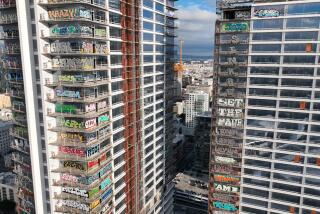Revival of Wilmington Depends on 2 Key Projects : Officials Say Hotel, Waterfront Plans Will Affect Growth
- Share via
Plans for the revival of Wilmington are moving forward, both on the waterfront, where a consultant has just begun work on a plan to give residents access to the harbor, and downtown, where plans are in the offing to renovate the run-down Don Hotel for offices.
City officials are hoping that the Don, a once-elegant landmark that now caters to transients and people on welfare, will become the cornerstone of their efforts to revitalize Avalon Boulevard, Wilmington’s main business thoroughfare.
Recreational Showpiece
And residents are looking to the consultant, Baltimore-based RTKL Associates Inc., to come up with a plan to convert the industrial waterfront at the foot of Avalon Boulevard into a commercial and recreational showpiece overlooking the Port of Los Angeles.
Taken together, the projects represent a significant step for the Wilmington community, which is struggling to overcome its image as the blighted stepchild of the port.
Both projects are in their earliest stages, and--especially in the case of the Don Hotel--community leaders and city officials predict that the results will have an important influence on development in Wilmington.
The Don Hotel is “a crucial development for the commercial corridor,” said Greg Dimmitt, the city Community Development Department staff member who oversees the downtown revitalization effort. Dimmitt proposes that the city assist in the renovation by giving the hotel’s owner low-interest loans.
“It’s right next to the town square,” Dimmitt added. “It’s the largest commercial building in town, and it’s a landmark building, too. If this project does not go forward, then that basically means there’s a very blighted corner in Wilmington . . . and that makes further redevelopment very difficult.”
And if the project does go forward, said Simie Seaman, president of the Banning Park Neighborhood Assn., it must be done tastefully, because its style will set the tone for the area.
“It could be a catalyst, if it’s done correctly,” she said. “If it’s not done correctly, then we’ve lost the ball again, we’ve dropped the ball.”
The decision to renovate the hotel is a turnabout for its owner, Cesar Lopez, who last year put the Don up for sale. At that time, city officials were threatening to condemn the building because Lopez had failed to reinforce it against earthquakes four years after being ordered to do so. Lopez’s real estate agent, Laura Warren, had said that prospective buyers would likely raze the hotel.
Lopez, who owns an import-export firm, was out of the country and could not be reached for comment. But Warren said he has completed most of the earthquake work and is planning to transform the 135-room hotel into offices by gutting and rebuilding its interior and by refurbishing the brick exterior.
Cost May Reach $4 Million
Both Warren and Dimmitt said the project could cost as much as $4 million. Although the city is permitted to loan a maximum of $1 million for such projects, Dimmitt said he will ask the department to waive that cap.
“Basically, I’m going to try and get whatever I can to make the deal work,” he said.
Whether the renovation could proceed without city assistance is unclear. Warren maintained that it could be done privately, but said that is less likely.
Those involved with the efforts to revitalize Wilmington agree that of the two projects, the Don’s prospects are less certain than those of the waterfront development. But community leaders have questions--and differing opinions--about what form the waterfront development should take.
“I would like something down at the foot of Avalon that is going to bring in tourists,” said Gertrude Schwab, a Wilmington community activist. “This is what we need in the community. And we need an office building at the foot of Avalon, and you need a restaurant down there and a viewing area.”
Said JoAnn Wysocki, vice president of Wilmington Home Owners: “I would like a place down there where people don’t have to have money to afford it . . . . The uses should be for as many people as possible: a play yard, a community building. Something that doesn’t involve money.”
What happens at the waterfront will depend, in part, on the consultant’s study.
The consulting firm, which played a role in transforming Baltimore’s waterfront, was hired earlier this month by the Los Angeles Board of Harbor Commissioners to work with a citizens committee in planning the waterfront.
The $172,000 study will take about eight months and will examine a variety of issues, including traffic patterns, environmental concerns and the economic climate in Wilmington, said Nelson Hernandez, the port staffer overseeing the project.
The consultant is supposed to mold the committee’s views into a workable plan. But the committee, which was appointed by the harbor commissioners, may want more than the Harbor Department is willing to give.
The department has set aside 30 acres near Slip No. 5 for community development, but the land has an odd configuration and most of it does not border the waterfront.
The citizens committee, which has been meeting since January, is pressing for the commissioners to expand the study area. But the commissioners have not yet considered that proposal.
Pet Food Cannery
One of the committee’s suggestions involves including the Heinz pet food cannery in the study area. The panel wants the cannery, which is closing, converted into a restaurant. Los Angeles Councilwoman Joan Milke Flores backs this idea, and has asked harbor officials to keep the cannery building intact after the pet food company moves out.
The committee’s five-phase expansion plan also proposes that the city Department of Water and Power give up its Wilmington tank farm so the community may use the land, and that the Wilmington Liquid Bulk company, a major tenant of the port, relocate to clear additional waterfront property for commercial and recreational use.
Hernandez said those wishes will have to be tested against “realistic constraints.”
But Seaman, the Banning Park community leader, said, “My concern right now is that they don’t lock us into that little specific area that they’ve given us.”
More to Read
Sign up for Essential California
The most important California stories and recommendations in your inbox every morning.
You may occasionally receive promotional content from the Los Angeles Times.






